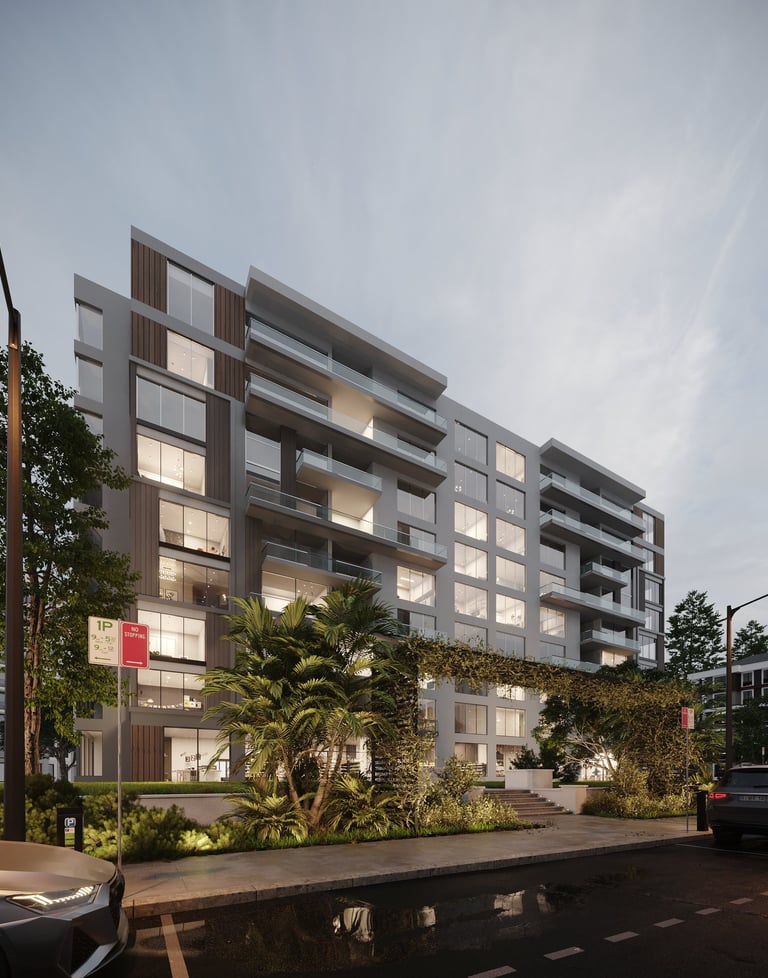What is 3D Exterior Rendering and Why You May Need It
Roman Marchyshak
8/26/20247 min read


Let’s start with the basics. According to Wikipedia, 3D rendering is a computer graphics process that converts 3D wireframe models into 2D images, often with photorealistic effects. While this might sound technical, let’s break it down. 3D exterior rendering is about crafting lifelike images of buildings or landscapes for portfolios. This process covers everything—from the building itself to the road next to it, the birds in the sky, and even the lighting to simulate different times of day. At Perspective Project, we take realism a step further by adding people to the scene, creating a fully immersive experience for our architectural portfolio.
Now that we’ve covered the basics, let’s dive into the various types of exterior 3D rendering.
Types of 3D exterior rendering
There are several main approaches to 3D rendering, each with its own characteristics and purposes. Let’s analyze the main ones:
Photorealistic 3D rendering
This is the most prevalent form of exterior visualization, aimed at producing highly detailed CG images that closely resemble real-life. It involves precise replication of textures, lighting, and atmospheric effects. This type of rendering is perfect for final architectural presentations, marketing materials, and regulatory approvals where accuracy in detail is crucial. In other words, it’s the ideal solution for showcasing a project to stakeholders, ensuring that the finished result aligns closely with the visual representation.
This type offers dynamic interaction with a 3D model, enabling users to assess changes in lighting, textures, and other elements in real-time, including tweaks to render resolution. It is extensively used in virtual reality (VR) and interactive demonstrations, making it essential for architectural walkthroughs and interactive design sessions. By providing full immersion in the project at any moment, complete with high-definition render quality, it leaves a lasting impression on the end user.
What is a 3D exterior rendering?


Real-time rendering
Non-photorealistic rendering (NPR)
This type of rendering is used to create images that resemble artwork rather than precise, photorealistic depictions. These images can look like drawings or sketches, making them ideal for the early design stages when the focus is on conveying a broad concept without delving into details.
Each of these rendering styles has its own specific role and can be strategically employed to enhance the presentation and comprehension of architectural designs within the architectural visualization industry. By selecting the appropriate rendering type, architects and developers can more effectively communicate their vision, ensuring that their projects are clearly understood and appreciated by clients, investors, and the public.
The role of exterior 3D rendering in building design and construction
The role of exterior 3D rendering in building design and construction has seen remarkable growth, becoming a vital component of the architectural process. As technology continues to advance, the capabilities and impact of 3D exterior visualization are expanding, offering significant advantages across various stages of architectural development.
Exterior 3D visualization acts as a crucial link between conceptual ideas and actual structures. By generating detailed and accurate renderings, architects and designers can visualize a building's entire exterior design before construction begins. This ability is essential not only for evaluating aesthetics but also for testing functionality, allowing for design adjustments that can significantly reduce costs and minimize resource waste during construction. Choosing the right camera angle in these renderings is key, as it can greatly enhance the visibility of architectural details and the overall perception of the space.
Moreover, 3D exterior renderings are instrumental in improving communication between architects, developers, stakeholders, and clients. These visualizations offer a clear and engaging representation of a project, making it easier for non-technical stakeholders to understand and connect with the design. This clarity is crucial for securing approvals and consents from planning authorities and investors, streamlining the path to project realization.
In the competitive world of real estate development, the ability to present architectural projects in the most visually compelling way can significantly influence decision-making. High-quality 3D exterior visualizations enable real estate developers to market properties effectively. By presenting realistic and appealing images of future buildings, potential buyers and tenants can make informed decisions, attracted by the visual appeal of the renderings.
The incorporation of new technologies such as augmented reality (AR) and virtual reality (VR) into traditional 3D rendering processes is setting new benchmarks in architectural visualization. These technologies offer immersive experiences, allowing clients and investors to take virtual tours of a building's exterior and interior before it is constructed. This immersive experience is particularly valuable for marketing high-end residential and commercial properties.
In conclusion, high-quality exterior rendering not only enhances design and construction processes but also plays a crucial role in marketing and client communication. As technology evolves, its integration into the architectural and construction industries is expected to deepen, introducing more advanced tools that will further revolutionize these fields.


Who needs 3D exterior visualization?
3D exterior visualization has become essential across various industries, enhancing planning, development, marketing, and engagement in architectural projects. Here's a closer look at who benefits from this technology and how:
Designers
Designers, especially those in landscape and urban planning, greatly benefit from 3D exterior visualization to create and present their projects. This tool allows them to visualize outdoor spaces—such as gardens, parks, and public areas—in a realistic setting, helping them understand how these designs integrate with architectural elements. Designers can experiment with different layouts, materials, and plant arrangements, exploring both aesthetic and functional aspects of exterior design. For client presentations, these visualizations offer a tangible representation of the designer's vision, making decision-making and approvals much easier. Additionally, it enhances communication, ensuring that all parties involved—whether clients, contractors, or regulatory bodies—have a clear understanding of the project within its context.
Architects
Architects rely on 3D exterior visualization to bring their design concepts to life, offering a clear depiction of their architectural style and intentions. This aids in refining design elements before construction and helps convince clients and stakeholders by presenting an immersive, photorealistic view of proposed projects. It also allows architects to experiment with different design solutions and visualize how their projects will impact the existing environment.
Real Estate Agents
Real estate agents use 3D visualizations to create compelling marketing materials that present properties in the most attractive way possible. By offering potential buyers and tenants photorealistic images and virtual tours of properties, they can significantly boost interest and accelerate sales or rentals. This tool is especially valuable for pre-selling residential buildings or leasing commercial spaces before construction is completed.
Large Companies
Large companies, often involved in extensive development projects, require detailed planning and visualization. Exterior rendering services allow these companies to visualize new facilities, expansions, or renovations and assess their impact on the corporate campus or infrastructure. This visualization helps align projects with strategic business objectives and facilitates communication across departments.
Builders
Builders benefit from 3D exterior visualization by gaining a detailed understanding of a project before construction begins. This technology helps prevent construction errors by providing a visual reference and assisting in identifying potential issues during the construction process. It also helps manage client expectations by showing them what the finished structure will look like.
Corporations
For large corporations, particularly those with significant real estate holdings, 3D exterior visualizations are critical for detailed planning and execution of construction projects. They aid in decision-making regarding property developments, facility upgrades, and the establishment of new branches or offices, ensuring that all developments align with the corporate image and operational needs.
Homeowners
Individual homeowners planning to build custom homes use 3D visualizations to preview their new homes before they are built. This helps them make informed decisions about exterior design elements, materials, and layouts. It also enables homeowners to communicate more effectively with architects and builders, ensuring the final product meets their expectations.
Citizens
Citizens and community groups often need 3D visualizations to understand new developments within their communities. These visualizations are used in public consultations and presentations, offering a clear picture of proposed changes and their impact on the neighborhood. This fosters transparency and allows for informed community feedback and engagement.
3D exterior visualization, including residential rendering, serves a wide range of users by providing a powerful tool for visualization, planning, communication, and marketing. As this technology continues to advance, its role in the architectural, construction, and real estate industries becomes increasingly crucial, driving innovation and improving outcomes across all stages of property development, particularly in residential projects.
Impact of 3D exterior rendering on design and creativity
3D exterior rendering has revolutionized architectural design and creativity, giving architects and designers an unparalleled ability to visualize, experiment, and refine their projects in real-time before construction begins. This section delves into how this technology has enhanced the design process and unlocked new creative potential.
Enhanced Visualization:
With 3D exterior rendering, designers can bring their ideas to life in ways that traditional sketches and 2D drawings simply can't match. This capability provides a deeper understanding of how buildings and spaces will appear and interact with their surroundings, encouraging more innovative and bold architectural solutions.
Improved Design Accuracy:
Exterior rendering services enable the detection of design flaws that may go unnoticed in conventional blueprints or models. By identifying and resolving these issues early in the design process, architects can avoid costly changes during construction, leading to smoother and more efficient project execution.
Facilitated Client Communication:
Exterior rendering services offer architects a powerful tool to communicate their ideas to clients more effectively. Clients can visualize the final product more clearly, which helps in securing approvals more quickly. This also allows for easier adjustments based on client feedback, ensuring that the final design meets their expectations.
Encouragement of Experimentation:
The flexibility of exterior rendering software allows designers to quickly and easily experiment with different materials, colors, and layouts. This flexibility fosters creativity and innovation, enabling designers to explore a wide range of aesthetic and functional options without the limitations of physical model building.
Integration with Emerging Technologies:
The combination of 3D exterior renderings with technologies like virtual reality (VR) and augmented reality (AR) has opened up new possibilities for immersive design experiences. Architects can now virtually walk through their rendered spaces, gaining a deeper understanding of spatial dynamics and aesthetic appeal, which can spark further creative ideas.
Environmental and Sustainable Design:
3D exterior visualization also plays a vital role in promoting environmental sustainability. It allows architects to simulate how environmental factors like sunlight, wind, and terrain will impact a building. This capability leads to the design of energy-efficient buildings that are both cost-effective and environmentally friendly.
Overall, exterior renderings have become an essential tool in architecture, profoundly influencing how buildings are designed, presented, and perceived. As technology continues to advance, its impact on design creativity and architectural innovation only grows, expanding the possibilities of what can be achieved in architecture.
